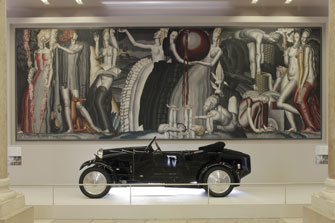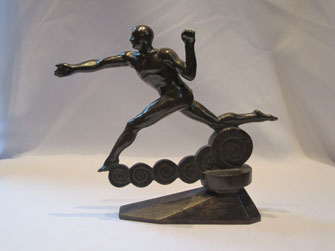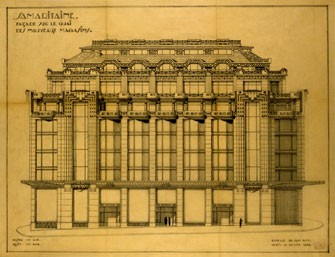Everything You Ever Wanted
To Know about Art Deco

A Bugatti type 40 (1927) in front of the painting “Le Vin et la Vigne” (1925), by Jean Dupas. © Capa/Gaston Bergeret, 2013
The exhibition “1925: Art Deco Wins over the World,” at Paris’s Cité de l’Architecture et du Patrimoine, is jam-packed with interesting exhibits on the Art Deco style, which took its name from the Exposition Internationale des Arts Décoratifs et Industriels Modernes, held in Paris in 1925. The core of the show spotlights that historic exhibition, which served as an international showcase for this then-radical style, with its geometric forms and simplified motifs.
This ambitious (overambitious might be more accurate) show reaches far beyond the 1925 exposition, however. One point it makes strongly is that Art Deco was not just about

Various examples of Art Deco design. Photo © Capa/Gaston Bergeret, 2013
furniture or architecture; it united artists and artisans and touched every creative field. This is well illustrated here, with examples of Art Deco design in architecture, furniture, the graphic arts, fabrics, fashion, cinema, automobiles, ceramics, ocean liners and more.
The influence of technological advances in aviation and other fields as the world speeded

One of a wonderful display of Art Deco car radiator caps. Photo © Michel Legrand
up and moved forward is brought out, along with social factors like women’s emancipation and the Roaring Twenties, both of which certainly influenced fashion – the revolutionary dresses of designer Paul Poiret, who freed women from petticoats and corsets, are given as an example. The point is also made that Art Deco’s simpler geometric forms lent themselves to industrial production.
Various other influences, like African art, are included, although I’m not sure how the American performer Josephine Baker, shown on film dancing and talking to the press, is relevant here (the curators say that by dancing unclothed she served as a “reminder of what modern art owed to African culture,” which seems a rather spurious connection).
Most of the exhibition focuses on the French contribution to the movement, but at the end, in a series of alcoves off the main room, the spread of Art Deco architecture around the

The Art Deco facade, designed by Henri Sauvage, of the Samaritaine department store on the Quai du Louvre. © Fonds Henri Sauvage, SIAF/Cité de l’architecture & du patrimoine/Archives d’architecture du XXe siècle.
world is illustrated with photos, drawings and, in each space, a handsome wall-sized backlit photo of a major building in a particular place, e.g., Shanghai, Brazil, Southeast Asia or North America (oddly, most of the buildings featured for the latter are in Canada rather than New York or Chicago).
Unfortunately, the story of Art Deco is poorly served by the exhibition’s layout and scenography. Right at the beginning, for example, it is explained that this radical new look was in great part a reaction to the curvy lines and floral motifs of its predecessor, Art Nouveau, which was itself a reaction to 19th-century academic styles. In the very next display, however, an opportunity to illustrate transitional phases between styles is completely lost. Two pieces by the designer Louis Süe (1875-1968) are presented, one a chair dating from 1912, the other a console table from 1935. Neither looks like what we consider today to be Art Deco – the chair has a floral motif and curved top rail, and the table stands on gracefully curving legs – but no explanation of how these untypical pieces fit into the development of Art Deco is offered.
This leads us to another problem. Most of the labels group together descriptions of individual pieces, with a diagram (sometimes wrongly numbered) to identify each one, and are placed to one side. With the crowds this show is attracting, it is difficult to go back and forth to figure out which text describes which object. The illogical layout of the diagrams, which often does not correspond to the placement of the pieces, adds to the confusion.
On top of this, the exhibition is held in a hot, stuffy, low-ceilinged space, making a visit a rather unpleasant experience. That is truly a shame, because the subject is so popular, and there is so much to be said and shown about it.
The exit from the show took us through a long stretch of wide, empty hallway. We wondered why this space had not been used to better spread out the exhibits in this huge show.
Do go to see it, but remember to check your coat so you won’t faint from the heat, and don’t go on the weekend, when it is especially packed with visitors.
Cité de l’Architecture et du Patrimoine: Palais de Chaillot, 1, place du Trocadéro, 75116 Paris. Métro: Trocadéro. Tel.: 01 58 51 52 00. Open Wednesday-Monday, 11am-7pm (until 10pm on Thursday). Closed Tuesday. Admission: €9. Through March 3, 2014. www.citechaillot.fr
Reader Michael Barker writes: “One notable aspect of Art Deco not displayed in this show (lack of space, the curator told me) was stained glass, prodigiously produced between the wars. Its beauty can be experienced in the little-visited 1930s Paris churches St. Pierre de Chaillot and St. Jean Bosco.”
Click here to read all of this week’s new articles on the Paris Update home page.
Reader reaction: Click here to respond to this article (your response may be published on this page and is subject to editing).
Please support Paris Update by ordering books from Paris Update’s Amazon store at no extra cost. Click on your preferred Amazon location: U.K., France, U.S.
More reviews of Paris art shows.
© 2014 Paris Update
Favorite